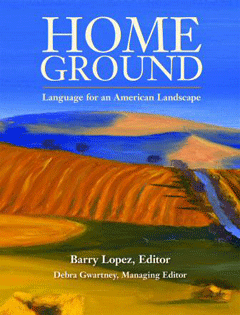The Language of Landscape
Air Date: Week of April 27, 2007

Home Ground: Language for an American Landscape, edited by Barry Lopez and Debra Gwartney. (Courtesy of Trinity University Press)
Alaskan writer Eva Saulitis fills us in on the term “tidal bore.” Her essay is included in the book “Home Ground: Language for an American Landscape," which was edited by Barry Lopez and Debra Gwartney.
Transcript
YOUNG: There are places in the American landscape that are unlike anywhere else in the world, places that stand out, grab the memory like no other. We’ve been chronicling some of these unique natural features in our periodic series: Home Ground: Language for an American Landscape. This week, writer Eva Saulitis brings us her definition of a rare … and sometimes exciting phenomenon known as the Tidal Bore.
SAULITIS: Tidal bore. A term coined by seamen around 1600, tidal bore describes a violent wall of water rushing up a shallow narrowing river, estuary, or bay. Bores, also called bore tides, form when an incoming tide meets a particular geography a resistance: sand, silt bars, narrowing channels and heaps water up to 15 feet high moving inland at 10 to 15 miles per hour.
[MUSIC: Adam Snider “The Anger of God” from ‘Berkeley Guitar’ (Tompkins Square – 2006)]
Most bores build after low water of a spring tide, the year’s biggest tidal flux. Famous bore tides occur in the Truro River in Canada’s Bay of Fundy and at Turnagain Arm in Alaska’s Cook Inlet. The latter driven by a tidal rise of 30 feet in six hours.

Home Ground: Language for an American Landscape, edited by Barry Lopez and Debra Gwartney. (Courtesy of Trinity University Press)
In summer, travelers driving along Turnigain Arm can witness wind surfers bundled in dry suits dancing along the waves face. Their brightly colored sails a dramatic contrast to the gray silty inlet. When it surges up the lower Amazon the bore, pororoca can shave forests and destroy homes. It is greatly feared by locals yet ridden by elite surfers from around the world.
YOUNG: Eva Saulitis is a writer, teacher and marine biologist from Homer, Alaska. Her definition of “Tidal Bore” appears in the book Home Ground: Language for an American Landscape edited by Barry Lopez and Debra Gwartney.
[MUSIC: Adam Snider “The Anger of God” from ‘Berkeley Guitar’ (Tompkins Square – 2006)]
Links
Living on Earth wants to hear from you!
Living on Earth
62 Calef Highway, Suite 212
Lee, NH 03861
Telephone: 617-287-4121
E-mail: comments@loe.org
Newsletter [Click here]
Donate to Living on Earth!
Living on Earth is an independent media program and relies entirely on contributions from listeners and institutions supporting public service. Please donate now to preserve an independent environmental voice.
NewsletterLiving on Earth offers a weekly delivery of the show's rundown to your mailbox. Sign up for our newsletter today!
 Sailors For The Sea: Be the change you want to sea.
Sailors For The Sea: Be the change you want to sea.
 The Grantham Foundation for the Protection of the Environment: Committed to protecting and improving the health of the global environment.
The Grantham Foundation for the Protection of the Environment: Committed to protecting and improving the health of the global environment.
 Contribute to Living on Earth and receive, as our gift to you, an archival print of one of Mark Seth Lender's extraordinary wildlife photographs. Follow the link to see Mark's current collection of photographs.
Contribute to Living on Earth and receive, as our gift to you, an archival print of one of Mark Seth Lender's extraordinary wildlife photographs. Follow the link to see Mark's current collection of photographs.
 Buy a signed copy of Mark Seth Lender's book Smeagull the Seagull & support Living on Earth
Buy a signed copy of Mark Seth Lender's book Smeagull the Seagull & support Living on Earth

